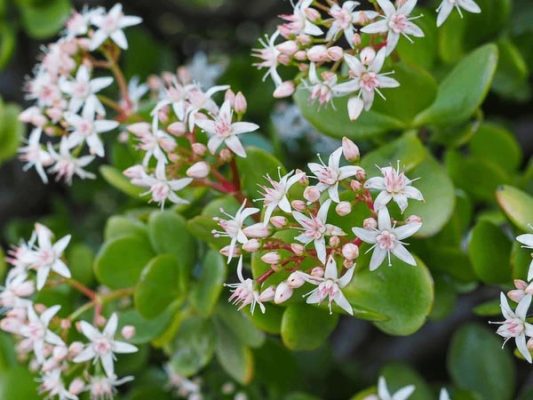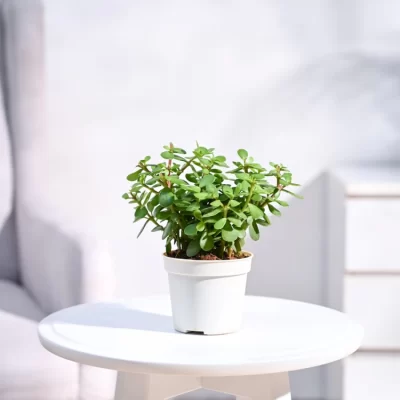
7 Easy Steps to Thriving Jade Lucky Plant at Home
Jade plants, with their thick, glossy leaves and charming resilience, have become a favorite among houseplant enthusiasts. Not only do they add a touch of green to any space, but they also require minimal care, making them perfect for beginners and busy individuals alike. In this comprehensive guide, we’ll explore seven simple steps to help you grow healthy and vibrant jade plants in the comfort of your own home.
Easy Steps to Thriving Jade Lucky Plant at Home
Step 1: Choosing the Right Pot and Soil
The journey to growing a beautiful jade plant begins with selecting the appropriate pot and soil. Opt for a well-draining pot with ample drainage holes to prevent waterlogging, as jade plants are susceptible to root rot. Additionally, use a well-draining soil mix specifically formulated for succulents or cacti. This mix will provide the necessary aeration and drainage while retaining just the right amount of moisture for your jade plant to thrive.

Also Read This : Bye-Bye Weeds: 10 Simple Strategies for Weed Control
Step 2: Selecting the Ideal Location
Jade plants are native to arid regions and thrive in bright, indirect sunlight. Place your jade plant near a sunny window where it can receive several hours of sunlight each day. However, avoid placing it in direct sunlight for extended periods, as this can cause sunburn and damage the leaves. A south-facing window is often the best choice, but east or west-facing windows can also work well.
Also Read This : 10 Varieties of Lawn Grass: A Comprehensive Guide
Step 3: Watering Wisely
One of the most common mistakes in caring for jade plants is overwatering. These succulents store water in their fleshy leaves and stems, making them highly drought-tolerant. Allow the soil to dry out completely between waterings, and then water deeply until water drains from the bottom of the pot. During the winter months when jade plants are dormant, water sparingly to prevent root rot.
Also Read This : 7 Must-Grow Vegetables for Your March Kitchen Garden
Step 4: Providing Proper Nutrition
While jade plants are not heavy feeders, they can benefit from occasional fertilization during the growing season. Use a balanced, water-soluble fertilizer diluted to half-strength and apply it every 2-4 weeks from spring to early fall. Avoid fertilizing during the winter months when the plant is dormant. Remember, it’s always better to under-fertilize than over-fertilize to prevent nutrient build-up in the soil.

Also Read This : Selecting the Superior Potting Soil: A Guide for Flourishing Plants
Step 5: Pruning for Health and Shape
Regular pruning is essential for maintaining the health and shape of your jade plant. Remove any dead, damaged, or yellowing leaves as soon as you notice them to prevent the spread of disease and encourage new growth. You can also prune your jade plant to control its size and shape, making it a more compact and bushy plant. Use clean, sharp scissors or pruning shears to make clean cuts and avoid tearing the plant’s tissues.
Also Read This : Keep Your Curry Leaves Green Year-Round: Easy Tips for Vibrant Garden Growth
Step 6: Preventing Pests and Diseases
Jade plants are relatively pest-resistant, but they can occasionally attract common houseplant pests such as mealybugs and spider mites. Inspect your plant regularly for any signs of pests, such as sticky residue, webbing, or tiny insects. If you notice any pests, gently wash the leaves with a mild soap solution or treat the plant with neem oil to eliminate them. Additionally, avoid overwatering and ensure proper air circulation to prevent fungal diseases such as powdery mildew.
Also Read This : 10 Effective Methods to Create Shade in Your Garden
Step 7: Propagating and Repotting
Once your jade plant has outgrown its pot or you want to share its beauty with others, you can propagate new plants from stem or leaf cuttings. Simply take a healthy stem cutting or pluck a few leaves from the plant, allow them to callus for a few days, then plant them in a well-draining soil mix. Keep the soil lightly moist and provide bright, indirect light until new roots form. Repot your jade plant every 2-3 years to refresh the soil and provide more room for growth.

Also Read This : Beat the Heat: Essential Gardening Tips for Thriving Plants in Summer
With just a little care and attention, anyone can enjoy the beauty of jade plants in their home. By following these seven easy steps, you can ensure that your jade plant thrives and continues to brighten your space for years to come. So go ahead, embrace your green thumb, and watch your jade plant flourish!




